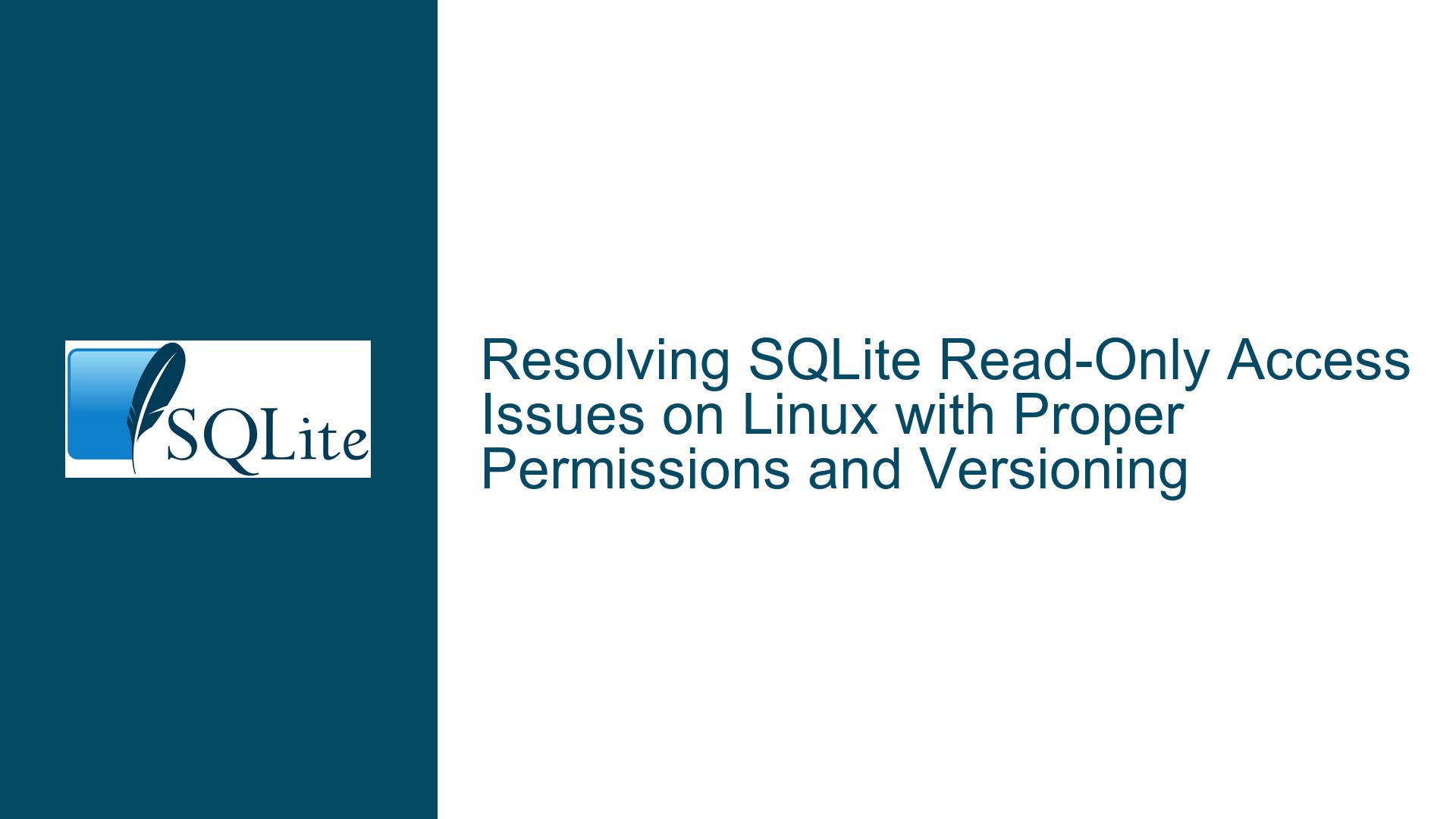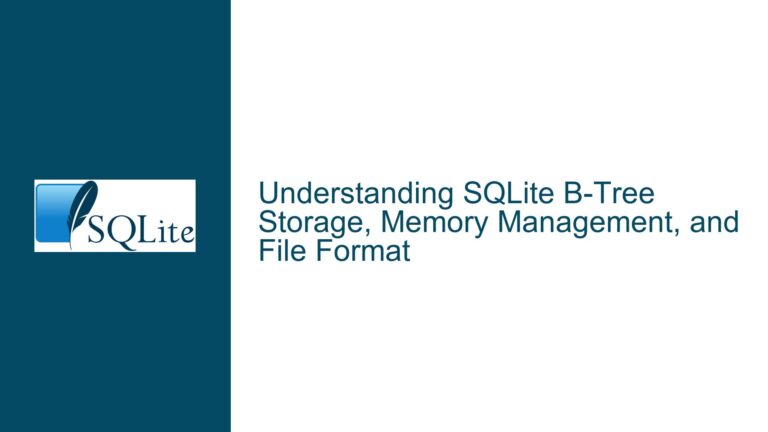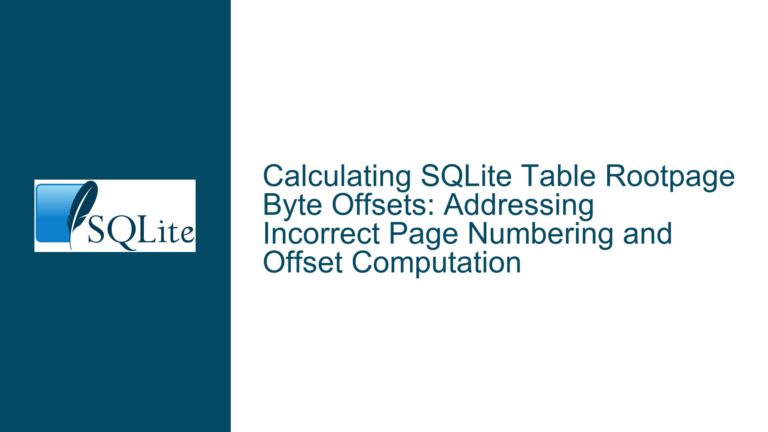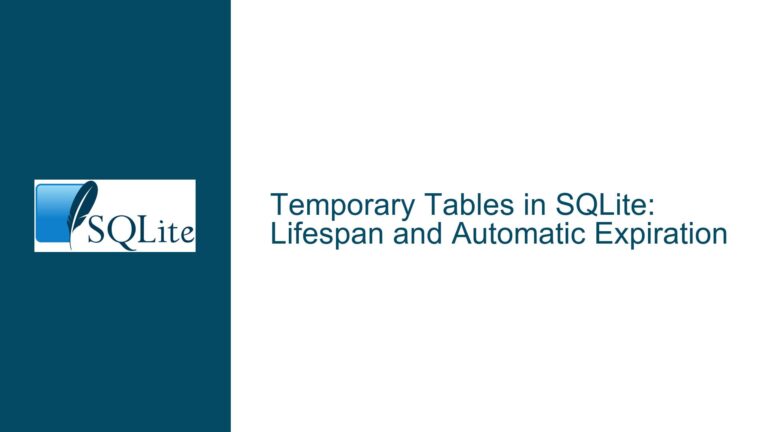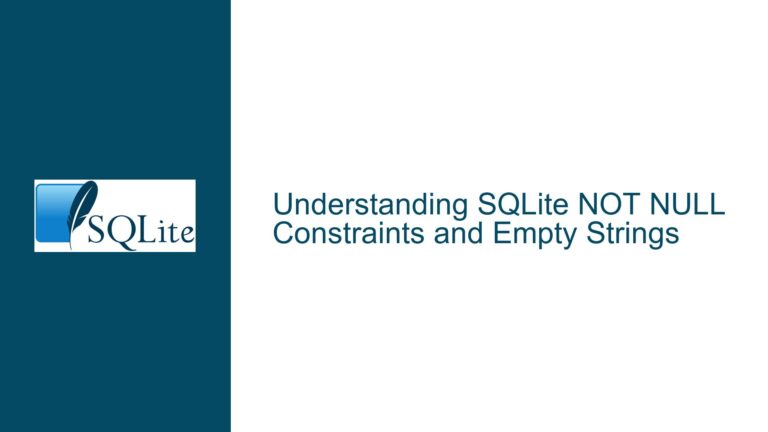Resolving SQLite Read-Only Access Issues on Linux with Proper Permissions and Versioning
Understanding SQLite Read-Only Access and File Permissions on Linux
The core issue revolves around configuring SQLite databases on a Linux system to allow read-only access to all users while restricting write access to the database owner. This setup is crucial for scenarios where data integrity and security are paramount, such as in production environments where multiple users or services need to query the database without the risk of accidental or unauthorized modifications.
The database in question is owned by a service account named svc_merc_cdr_prod, and the database file (cdr_control.db) is located in a directory with specific permissions. The current setup allows the service account to read and write to the database, but other users encounter errors when attempting to access the database, even for read-only operations. The errors include "unable to open database file" and "attempt to write a readonly database," which suggest underlying issues with file permissions, SQLite version compatibility, or configuration settings.
Potential Causes of Read-Only Access Failures in SQLite
Several factors could contribute to the inability of non-owner users to access the SQLite database in read-only mode. These include outdated SQLite versions, improper file and directory permissions, and misconfigurations in the SQLite environment or application code.
Outdated SQLite Version: The discussion mentions SQLite version 3.7.17, which is significantly outdated. Modern versions of SQLite have introduced numerous improvements and features related to read-only access, such as the --readonly flag and enhanced support for Write-Ahead Logging (WAL) mode. Older versions may lack these features or have bugs that prevent proper read-only access.
File and Directory Permissions: The database file and its containing directory must have appropriate permissions to allow read access to other users. The current permissions (chmod 644) grant read and write access to the owner and read-only access to others. However, the directory containing the database file must also have execute permissions (chmod +x) for other users to traverse the directory and access the file.
WAL Mode and Shared Memory Files: If the database is using WAL mode, SQLite creates additional files (e.g., -wal and -shm) that require specific permissions. If these files are not accessible to other users, read-only operations may fail. Additionally, some filesystems or kernel configurations may impose restrictions that affect SQLite’s ability to operate in read-only mode.
JDBC Configuration and Application-Level Issues: The error "attempt to write a readonly database" when using a JDBC connection suggests that the application or driver may be attempting to perform write operations or misconfigured to request write access. This could be due to incorrect connection parameters, driver settings, or application logic.
Comprehensive Troubleshooting and Solutions for SQLite Read-Only Access
To resolve the read-only access issues, follow these detailed steps, ensuring that each potential cause is addressed systematically.
1. Upgrade SQLite to the Latest Version: Begin by upgrading SQLite to the latest stable version. As of the discussion, version 3.23.0 introduced the --readonly flag, and subsequent versions have further improved read-only functionality. Download the latest SQLite source code or precompiled binaries from the official SQLite website and install them on your system. If you lack administrative privileges, consider compiling SQLite locally or using a statically linked executable.
2. Verify and Adjust File and Directory Permissions: Ensure that both the database file and its containing directory have the correct permissions. The database file should have 644 permissions (-rw-r--r--), allowing read access to all users. The directory should have 755 permissions (drwxr-xr-x), enabling other users to traverse the directory and access the file. Use the following commands to set the permissions:
chmod 644 /opt/bigcdr/nlp/db/prd/control/cdr_control.db
chmod 755 /opt/bigcdr/nlp/db/prd/control
3. Configure WAL Mode and Shared Memory Files: If the database is using WAL mode, ensure that the -wal and -shm files have appropriate permissions. These files should be accessible to all users requiring read-only access. You can check the WAL mode status using the following SQL command:
PRAGMA journal_mode;
If the result is wal, ensure that the additional files have the correct permissions. You may need to adjust the umask settings or explicitly set permissions for these files.
4. Use the --readonly Flag for Read-Only Sessions: When accessing the database in read-only mode, use the --readonly flag with the sqlite3 command-line tool. This ensures that the session is explicitly set to read-only, preventing any accidental write operations. For example:
sqlite3 --readonly /opt/bigcdr/nlp/db/prd/control/cdr_control.db
5. Review JDBC Connection Parameters: For applications using JDBC to connect to the SQLite database, ensure that the connection URL includes the readonly parameter. This prevents the driver from attempting write operations. For example:
String url = "jdbc:sqlite:/opt/bigcdr/nlp/db/prd/control/cdr_control.db?readonly=true";
Additionally, verify that the application logic does not inadvertently attempt write operations, such as creating temporary tables or modifying database settings.
6. Test and Validate Read-Only Access: After implementing the above steps, thoroughly test read-only access from multiple user accounts and applications. Verify that non-owner users can successfully query the database without encountering errors. Use tools like sqlite3 command-line interface and JDBC-based applications to simulate real-world usage scenarios.
7. Monitor and Address Filesystem-Specific Issues: If issues persist, investigate filesystem-specific behaviors or kernel configurations that may affect SQLite’s operation. Some filesystems impose restrictions on file locking or shared memory access, which can impact read-only functionality. Consult your system documentation or filesystem vendor for guidance on configuring these settings.
By systematically addressing each potential cause and implementing the recommended solutions, you can achieve a robust configuration that allows read-only access to the SQLite database while maintaining strict write restrictions for the database owner. This ensures data security, integrity, and accessibility in multi-user environments.
